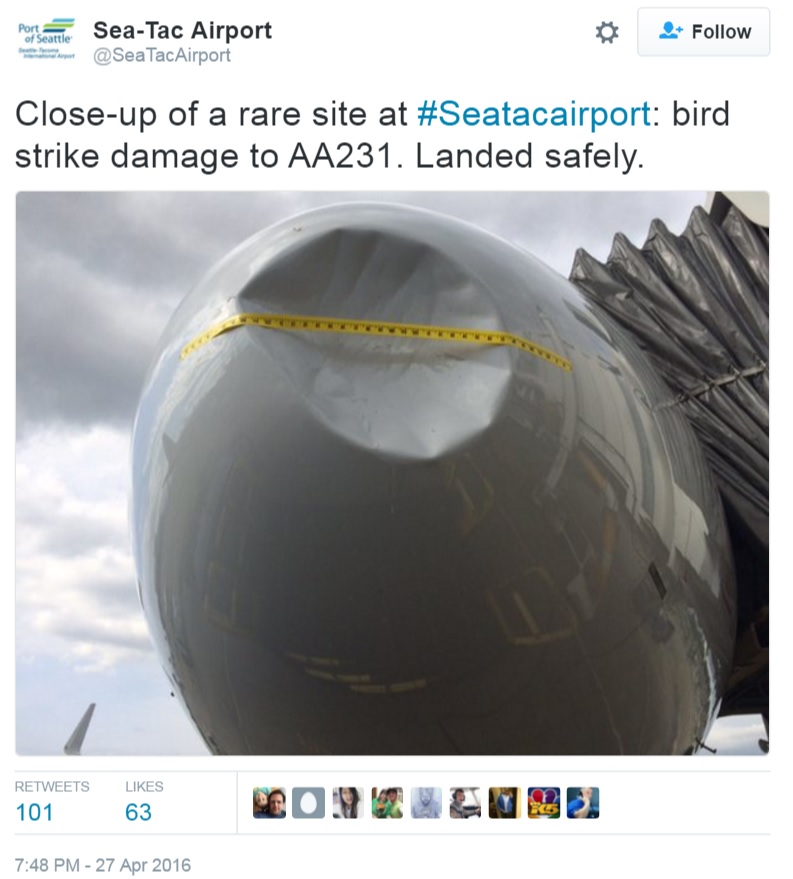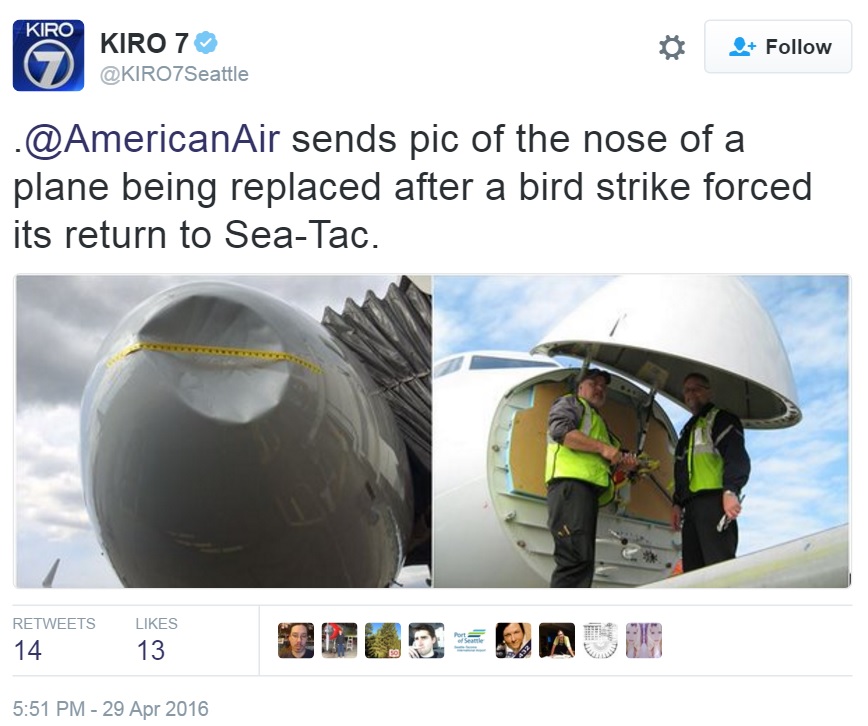Whether it’s a brand new American Boeing 787, an EgyptAir 737, or a United 777, aircraft incidents happen with surprising frequency.
We usually focus on the damage to planes in the event of a bird strike. But as they say, you should see the other guy.
Bird strikes happen far more often than drone strikes, but drones capture far more media attention. Of course, drones are flown by humans so in theory at least should involve incidents we can eliminate.
Earlier this week an American Airlines Airbus A321 from Seattle to Dallas suffered a bird strike on departure and returned to Seattle to assess damage.
The pilot told air traffic controllers, according to LiveATC.net: ‘Looks like we hit some birds after takeoff, we’re gonna need to go back and have the airplane looked at.’
The plane landed back at the airport a little less than an hour later, at 4:25pm. News crews who were on the scene took video of the Airbus A321 returning to the airport, with a large dent on the nose of the airplane.

The good news is that nose cones are replaceable.

I didn’t know that in the event of a bird strike they’ll investigate the bird.
The body of the bird or birds that struck the airplane will be sent to the Smithsonian to determine what kind of birds they are.


“I didn’t know that in the event of a bird strike they’ll investigate the bird.”
Sound like a job for the TSA!
When I took the ground school class to become a private pilot, our instructor — an old-time bush pilot — told us the real reason for the 250 kt speed limit under 10,000 feet of altitude was because the cockpit windows on planes are only certified to survive a bird strike up to 250 kts. Birds are unlikely to fly higher.
I didn’t know there was something you never knew.
As a Naval Aviator, I can tell you that bird strikes happen all the time. Most of the time, you don’t even realize that you hit the bird until after you land and do your post-flight inspection. That said, if you do notice, it is always safest to go land at the nearest suitable airport to have the aircraft checked out, so these guys did the right thing. Our birds were also sent to the Smithsonian to get analyzed, although I was always curious what they did with the data. Maybe someone here has more insight.
I do not envy the maintainers who have to collect the gut splatter all over the front of the wing, that’s for sure!
“Bird strikes happen far more often than drone strikes, but drones capture far more media attention.”
Have there been any confirmed drone strikes yet? Every one I’ve seen in the news has been later declared to not have actually been a drone strike.
“Bird strikes happen far more often than drone strikes, but drones capture far more media attention”
Since there have not been any hobbyist drone/manned aircraft collisions, why do you even bring this up except for continued fear mongering?
@jered @Michael B – I think we’re making the same point. Drone strikes aren’t actually a thing. And yet fear of drone strikes is a bigger thing than fear of bird strikes. Perhaps it shouldn’t be.
Bird strike remains are sent to the Smithsonian to determine species and identify if there any patterns or migratory issues at play. If you hit a bird and it turns out to be an unusual species for the area, it could be a long term potential problem.
@jered there was a report that a BA A320 struck a drone on approach to LHR, but it may have been a plastic bag…
@Michael B @Gary Leff there are laws that prohibit flight above a certain altitude and at a certain minimum distance away from airports, plus mandate registration if your drone is above a certain weight. Since this varies by country, I’ll leave the details as an exercise to the reader.
But out there will be Some Guy with his head not on straight…….
@Phoenix: That’s exactly my point — every news source led “OMG DRONE STRIKE WE’RE ALL GONNA DIE!!!!” and then the next day it was small print “false alarm, plastic bag.” Saying that “bird strikes happen far more often than drone strikes” suggests that drone strikes happen at all, and right now I can’t find a single confirmed report of a drone strike.